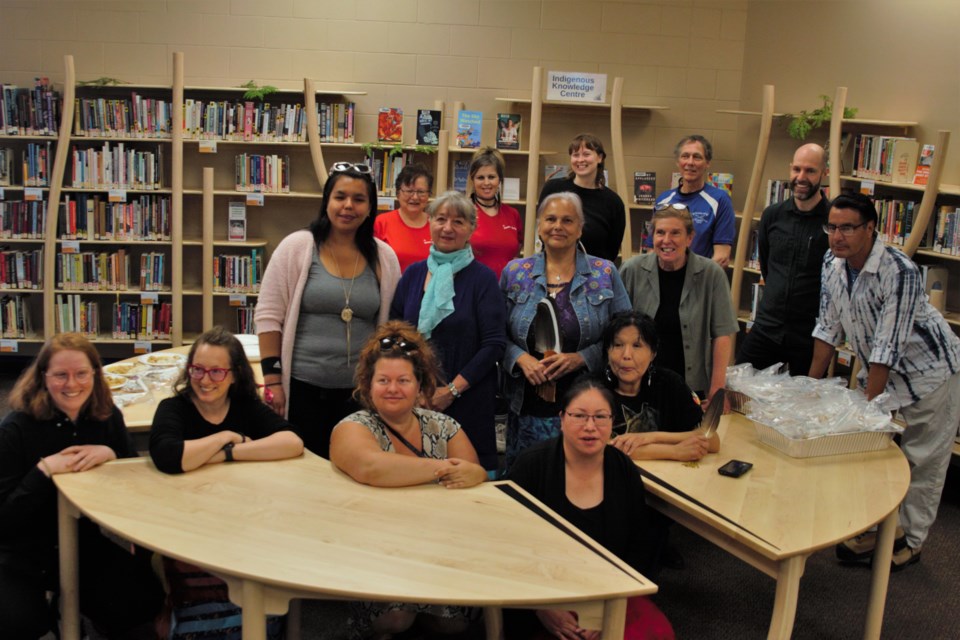THUNDER BAY — A collaboration between the Thunder Bay Public Library and furniture students at Sheridan College has helped build a unique expansion for the library’s Indigenous Knowledge Centre.
The centre, first introduced in 2018, has expanded to fill a large section of the Waverley branch’s upper floor, anchored around custom pieces designed collaboratively with members of the local Indigenous community.
Library leaders hope the expansion will bolster its plans to better serve Thunder Bay’s Indigenous population.
“In 2018, when the Indigenous Knowledge Centre opened at Waverley Library, it was a small space that was basically hidden in the corner,” said Robyn Medicine, a community hub librarian and Indigenous relationship supervisor with the TBPL.
“We had the students help us design a space that allowed us to really expand. It’s a growing collection … The furniture pieces allow the collection to grow, we have tons of display space now.”
The expansion will also support hosting more events like author readings in the knowledge centre, Medicine added.
The initiative follows the success of a previous collaboration with Sheridan that built pieces for the Brodie branch’s knowledge centre in 2020.
The new furnishings, including a large bookshelf, public access computer tables, coffee table and stools, and a central programming table, have a value approaching $100,000, said program leaders.
More valuable than that dollar figure, they said, is the way the pieces reflect ideas from the local community about how to make the space welcoming — and the unforgettable learning experience for students.
Clarissa Matasawagon, a member of the library’s Indigenous Action Council, was one of eight local participants who met with Sheridan students and faculty during a visit in January and offered design ideas based in Indigenous culture.
“I do believe it will change how many people come [visit] the library and makes it a better place,” she said. “I’ve been coming to this library for such a long time, and it’s so nice to see a really great big change.”
“The Indigenous Knowledge Centre has expanded, so it’s better for our people to come in and take a look at the library — more resources.”
Nora Langill, a third-year student in Sheridan’s furniture program, said a snowshoe the group took through the sugar bush on Anemki Wajiw, or Mount McKay, helped inspire her work on the new bookshelf.
“We were really inspired just by the visuals of the forest — the trees and the uprights of the branches, but also the snow beds hanging over the branches created this really interesting imagery that we tried to convey,” she said.
The shelf, built of solid maple and birch plywood, roughly doubled available shelf space in the centre.
A time-lapse video shows students assembling the new bookshelf at the Waverley library:
Participants played a key role, Langill said, suggesting imagery that would be meaningful to area Indigenous communities, sketching design ideas, and approving final concepts.
“We just let the participants take the reins and we went back to the machinery and made it happen,” she said. “It was all such a collaborative process.”
“I think that’s really important, because furniture is for users, and those are the people who need to be at the forefront of the design process.”
Participating in the project helped show how to put ideas around decolonizing design into practice, Langill added.
“Coming from an institution like Sheridan where the administration is trying hard to decolonize curriculum and really include Indigenous voices in our work, I think it’s so great we get to be a part of this experience listening to Indigenous stories and take part in a process like this.”
“It makes me feel like it’s possible in the design world to decolonize design, but it does have to come from these real relationships you form.”
Simon Ford, Sheridan’s acting furniture studio head, called the initiative a special example of the service projects students in the program typically complete with community organizations.
“I’m over the moon,” he said of the finished product. “To think that just eight students did all this furniture, it was a large undertaking for that size of class.”
Ford called the pieces complex from a fabrication standpoint, but said he was most impressed by how the students listened to participant feedback and incorporated it into their work.
“One of the major focuses was to get a sense of the feeling that the community wanted in the pieces that students were building, but also just trying to get a sense of what activities were going to happen in the space.”
“The community members were getting right in and drawing. There’s some images that you can directly see [how] that bookshelf came from a model … that a community member drew.”
The project was facilitated through Codesign, a charity that brings post-secondary design students together with Canadian communities to work on projects of mutual benefit.
Donors supporting the project include lumber supplier Goodfellow Inc., the John Andrews Foundation, the Metcalf Foundation, the Prince Arthur Hotel, Spec Furniture, and Sheridan College.



